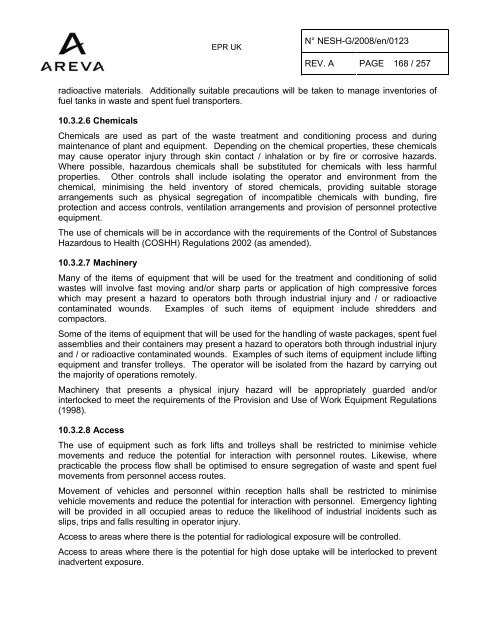Solid Radioactive Waste Strategy Report.pdf - UK EPR
Solid Radioactive Waste Strategy Report.pdf - UK EPR
Solid Radioactive Waste Strategy Report.pdf - UK EPR
Create successful ePaper yourself
Turn your PDF publications into a flip-book with our unique Google optimized e-Paper software.
<strong>EPR</strong> <strong>UK</strong><br />
N° NESH-G/2008/en/0123<br />
REV. A PAGE 168 / 257<br />
radioactive materials. Additionally suitable precautions will be taken to manage inventories of<br />
fuel tanks in waste and spent fuel transporters.<br />
10.3.2.6 Chemicals<br />
Chemicals are used as part of the waste treatment and conditioning process and during<br />
maintenance of plant and equipment. Depending on the chemical properties, these chemicals<br />
may cause operator injury through skin contact / inhalation or by fire or corrosive hazards.<br />
Where possible, hazardous chemicals shall be substituted for chemicals with less harmful<br />
properties. Other controls shall include isolating the operator and environment from the<br />
chemical, minimising the held inventory of stored chemicals, providing suitable storage<br />
arrangements such as physical segregation of incompatible chemicals with bunding, fire<br />
protection and access controls, ventilation arrangements and provision of personnel protective<br />
equipment.<br />
The use of chemicals will be in accordance with the requirements of the Control of Substances<br />
Hazardous to Health (COSHH) Regulations 2002 (as amended).<br />
10.3.2.7 Machinery<br />
Many of the items of equipment that will be used for the treatment and conditioning of solid<br />
wastes will involve fast moving and/or sharp parts or application of high compressive forces<br />
which may present a hazard to operators both through industrial injury and / or radioactive<br />
contaminated wounds. Examples of such items of equipment include shredders and<br />
compactors.<br />
Some of the items of equipment that will be used for the handling of waste packages, spent fuel<br />
assemblies and their containers may present a hazard to operators both through industrial injury<br />
and / or radioactive contaminated wounds. Examples of such items of equipment include lifting<br />
equipment and transfer trolleys. The operator will be isolated from the hazard by carrying out<br />
the majority of operations remotely.<br />
Machinery that presents a physical injury hazard will be appropriately guarded and/or<br />
interlocked to meet the requirements of the Provision and Use of Work Equipment Regulations<br />
(1998).<br />
10.3.2.8 Access<br />
The use of equipment such as fork lifts and trolleys shall be restricted to minimise vehicle<br />
movements and reduce the potential for interaction with personnel routes. Likewise, where<br />
practicable the process flow shall be optimised to ensure segregation of waste and spent fuel<br />
movements from personnel access routes.<br />
Movement of vehicles and personnel within reception halls shall be restricted to minimise<br />
vehicle movements and reduce the potential for interaction with personnel. Emergency lighting<br />
will be provided in all occupied areas to reduce the likelihood of industrial incidents such as<br />
slips, trips and falls resulting in operator injury.<br />
Access to areas where there is the potential for radiological exposure will be controlled.<br />
Access to areas where there is the potential for high dose uptake will be interlocked to prevent<br />
inadvertent exposure.

















